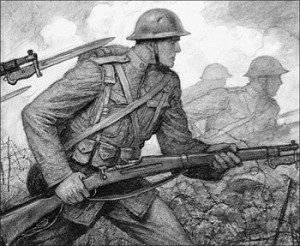
World War I and Its Aftermath (1914-1920)
Intro: Overview, Attendance, Agenda, Introduce Essential Question, Objectives, Standards
Enduring Understanding: Countries are affected by their relationships with each other.
Essential Question: Why do nations go to war?
Objectives:
—the major causes of World War I, including militarism, alliances, imperialism, and nationalism.
—what life was like on the home front for women and minorities.
—the new technology of warfare and its effect on military tactics and casualties.
—why the Red Scare developed after the war.
Standards:
…Time, Continuity and Change (#5)
…People, Places and Environments (#8)
…Power, Authority, & Governance (#4)
…Production, Distribution, and Consumption (#3)
…Science, Technology, and Society (#4)
…Global Connections (#2, 3, 5, 7)
…Civic Ideals and Practices (#2)
WWI: The Home Front
—Whole class reading pp. 383-387
—Whole class discussion
*****Why do you think the federal government undertook such wide-scale economic and social mobilization?
*****How did life change for women on the home front during WWI?
*****How did life change for African Americans on the home front during WWI?
*****Looking at the graph on p. 384, how much money did the U.S. government raise through loans? How much money did it earn through taxation? What consequences might result from the way the war was paid for?
*****How were the Americansʻ rights limited during WWI?
*****Why do you think some people were exempted from military service?
*****How did progressive ideas influence the roles of women during WWI?
—Complete vocab and reflection via Google Classroom
Homework: Finish reflection via Google Classroom
